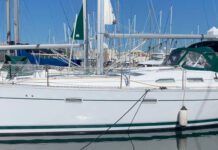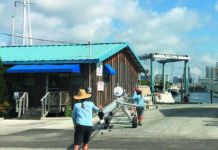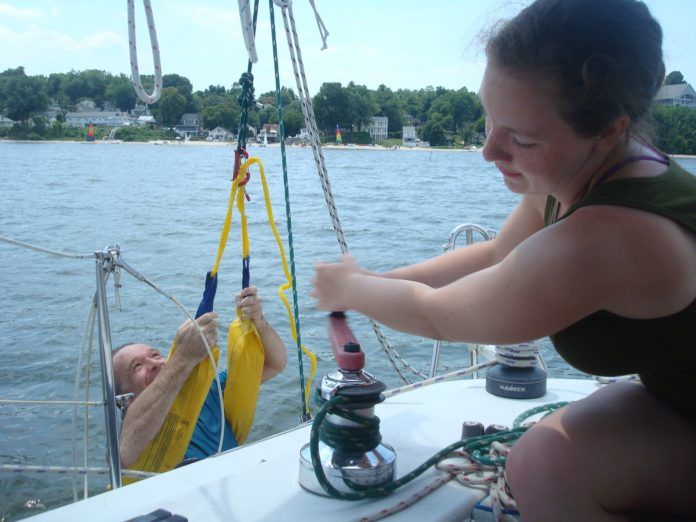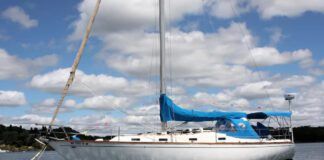For many sailors in the northern hemisphere winter is the off-season, which means it’s a great time inspect safety gear. Personal floatation devices (lifejackets) and throwable rescue aids (Lifeslings, horseshoe buoys) that incorporate materials that degrade over time deserve particularly close attention.
A few years back we received a letter from a reader describing the deterioration of the webbing beckets on their Lifesling. These are the loops of webbing that attach to the rescue retrieval line. The Lifesling appeared to be particularly old and was likely stored without a case and fully exposed to UV during part of its life. The original Lifesling was sold with storage bags that were notorious for falling apart, so the deterioration was no surprise. Fortunately, the new Lifesling2 is much improved over the original version.
We have a Lifesling2 aboard one PS test boat that’s nearly 20 years old; while the original case it’s always stored in has been doctored over time and is now on its last legs, the Lifesling2 float, webbing beckets, and polypropylene float line are in pristine condition.
Developed by The Sailing Foundation, Lifeslings have been in production for almost 40 years. The original Lifesling pre-dated its US Coast Guard certification, so the materials may not meet the current standards, which stipulate the types of materials suitable for construction. Over time, even the designated materials are susceptible to environment factors—UV rays, extreme cold, acid rain, biological growth, etc.
Even new safety equipment that meets USCG standards deserves close inspection. Probably the most startling failure we’ve experienced in safety equipment was a newly bought child’s safety harness with a polypropylene safety tether that immediately broke under very little load. The cause appeared to be UV exposure, and since the tether was new, we could only surmise that the device had been part of a window display, or had somehow been exposed to UV for a prolonged period before purchase.
Current Lifeslings, approved as Type IV (throwable) or Type V (special use) flotation devices, use the same polypropylene webbing commonly used on personal flotation devices (PFDs) and have all been tested to meet the webbing requirements for USCG-approved PFDs, according to the Lifesling’s distributor West Marine. This includes a minimum strength and resistance to weathering.
Polypropylene webbing’s UV resistance and longevity can vary greatly; some studies have shown that it can lose 20 to 75 percent of its strength per year. Nylon webbing, which the current Lifesling2 uses, loses about 10 percent of its strength per year. Polyester webbing loses only about 5 percent of its strength per year, which would seem to make it an even better choice of material. Fortunately, the Lifesling2 is designed so that the beckets are not exposed to UV when it’s stored properly in a good-condition bag or rigid case.
The Lifesling owners manual does not offer a timeframe for regular maintenance, inspection, or replacement, and the device’s longevity would be dependent upon a number of factors, including how it is stored, how often it’s used, and the environmental conditions where it’s stored. Hence the need for regular inspection, just as you would a PFD, and regular drills to determine whether the Lifesling can still handle the load of lifting crew.
Throwable Rescue Aid Recommendations
- Inspect Lifeslings of any age for UV damage (beckets, stitching, webbing tether, poly float line, horeshoe float); animal damage (the poly line makes a nice chew toy for squirrels and mice); or potential weak spots. Any degradation requires that the whole device be replaced.
- Load test the Lifesling regularly, especially if yours is an older model or if you plan to take it offshore.
- Pay close attention to the health of the storage bag or case. The bags’ Velcro closure often allows a gap in the top that can leave the float exposed to UV; consider replacing the Velcro with a closure that does not have a gap. OEM replacement bags ($50) are not high-quality or durable, in our opinion; Sunbrella bags ($80) are a better choice; rigid cases ($220) are the most durable option and are recommended for offshore use.
- Unpack and repack the Lifesling annually. Be sure that all critical parts are protected from the sun. For a good how-to on packing the Lifesling properly, visit http://theboatgalley.com/is-your-lifesling-ready-for-use-are-you-sure/.For more on safety equipment selection, inspection, and use, our ebook MOB Prevention and Recovery offers a comprehensive study.








































Also check safetyharnesses for their tendency to drown you while being towed alongside… as far as I know there exists only one that has a real solution – the Backtow by TeamO – but I may be mistaken…
There is a hard box for storage and I take mine below as with all safety kit, when not using the boat.
I’m on my third bag. I would make my own out of Sunbrella, which lasts pretty much forever, but then the printed instructions would be missing. I don’t think the Lifesling will last long out of the bag. Surprisingly, the velcro loops (made of nylon) seems to last, while the bag material just disintegrates.
Barry, the instructions are easily reprinted by any local sign company that does
digital printing and then applying it to a thin piece of pvc and sewing it onto the
Sunbrella.
Joe
No one can dispute the poor quality of the Lifesling bag but how many of you have tried to practice retrieve a man overboard. We did so years ago as a yacht club learning exercise. The object was to lift someone on board only. Most of the man overboard volunteers, if not all, complained that the under arm position the sling takes nearly breaks your back when lifted to the deck. This in ideal no wave conditions. We concluded that in sea state conditions the victim would not survive the retrieval and if so would most likely be paralyzed.
Good article.
I bought a new white Taylor Made 20″ life ring in 2015 from West Marine. My boat is kept in Cleveland, Ohio and is under white shrink wrap for five months a year. I leave the life ring on the stern rail in its bracket 12 months of the year. In the summer of 2019 the polypropylene grab line on the life ring fell apart. It looked good visually but it had lost all of its strength. We were shocked. Luckily it was not an emergency.
Another point of failure to watch: the bitter end of the retrieval line, where it exits the storage bag and is then secured to the boat. We kept a life sling on our Catalina 36 for 16+ years. At around the 10 year point, I noticed the nylon webbing UV cover on the end of the retrieval line had pulled away where the line exited the bag, exposing that segment of the line to full sunlight. The unprotected poly line had deteriorated to less than 50% original thickness; probably not strong enough to carry the load of a MOB. Easy fix with new webbing – but easy to miss.
You can get how-to instructions to make a new cover from Sailrite.com, a wonderful source for marine fabric and instruction.
I made a new Lifesling cover using the Sailrite kit. Good instructions, and an easy sewing project for anyone with a household sewing machine. Best part is having it the same color as the rest of my boat’s canvas.
I hate winter because I can’t go with my ships anymore, it is too cold. But you are right; this is the necessary time for us to rest and maintain the boat. Some of your recommendations are very good. I’m going to check the Lifeslings for my ship to make sure it’s safe. Thanks for sharing
I hate winter because I can’t go with my ships anymore, it is too cold. But you are right; this is the necessary time for us to rest and maintain the boat. Some of your recommendations are very good. I’m going to check the Lifeslings for my ship to make sure it’s safe. Thanks for sharing
I want to add to the comments about Lifesling web failures. Last summer, my wife and I were out for a casual weekend cruise on Chesapeake Bay. Having found a protected anchorage that appeared free of the pesky stinging nettles so common in the Bay, especially late in the summer, my wife decided to go for a vigorous swim. By the time she returned to the boat, she was exhausted and needed some help getting up our stern ladder. This seemed like a job where our Lifesling2 could easily be of assistance. However, once secured, as soon as I put tension on the rope, the webbing snapped. Of course, I was shocked by this. Fortunately, the conditions were calm, and with some additional help from yours truly, she soon was back onboard. I was shaken, not so much from what had happened, but by thinking about the possible consequences of such a failure occurring in a true rescue situation, not in a calm inlet, but in seaway conditions that might lead to a true MOB.
The Lifesling2 was 5 years old and I had replaced the bag 2 years before this incident, because of deterioration. The manufacturer’s customer service was good, as they quickly arranged for me to exchange the damaged item at my local West Marine store for a new replacement free of charge. Scary, however!
Years ago, when the cover was deteriorating, I made a sunbrella cover for the lifesling as well as covers for all the exposed lines. Thanks for reminding me to go back and check on their condition.
Sort of have the opposite problem. Well protected from UV, moisture got into the assembly and mildew developed. Any tips to get rid of mildew keeping in mind the cleaning product should not chemically affect to polypropylene?
We have a high freeboard sailboat with a midship boarding ladder on only one side. The previous owner had mounted the life sling in a clear and good-looking spot on the non-boarding ladder side of the boat. Big mistake that was a simple fix to change. Bringing even an agile MOB in the sling around the stern’s dingy davits or around the bow sprit in a sea would have been a nightmare. Practice makes these simple but critical issues obvious. Second lesson learned was there was no easy way to attach a halyard to the collar of the lifesling for winching an unconscious or weak MOB onboard without almost getting in the water yourself due to the high freeboard. This was solved by adding a permanent loop in the poly rope about 5′ above the life sling. Now attaching the halyard is done easily and safely from the deck. A third item to note is the knot you attach the bitter end of the life sling to the stern pulpit rail should be 100% covered from UV light.